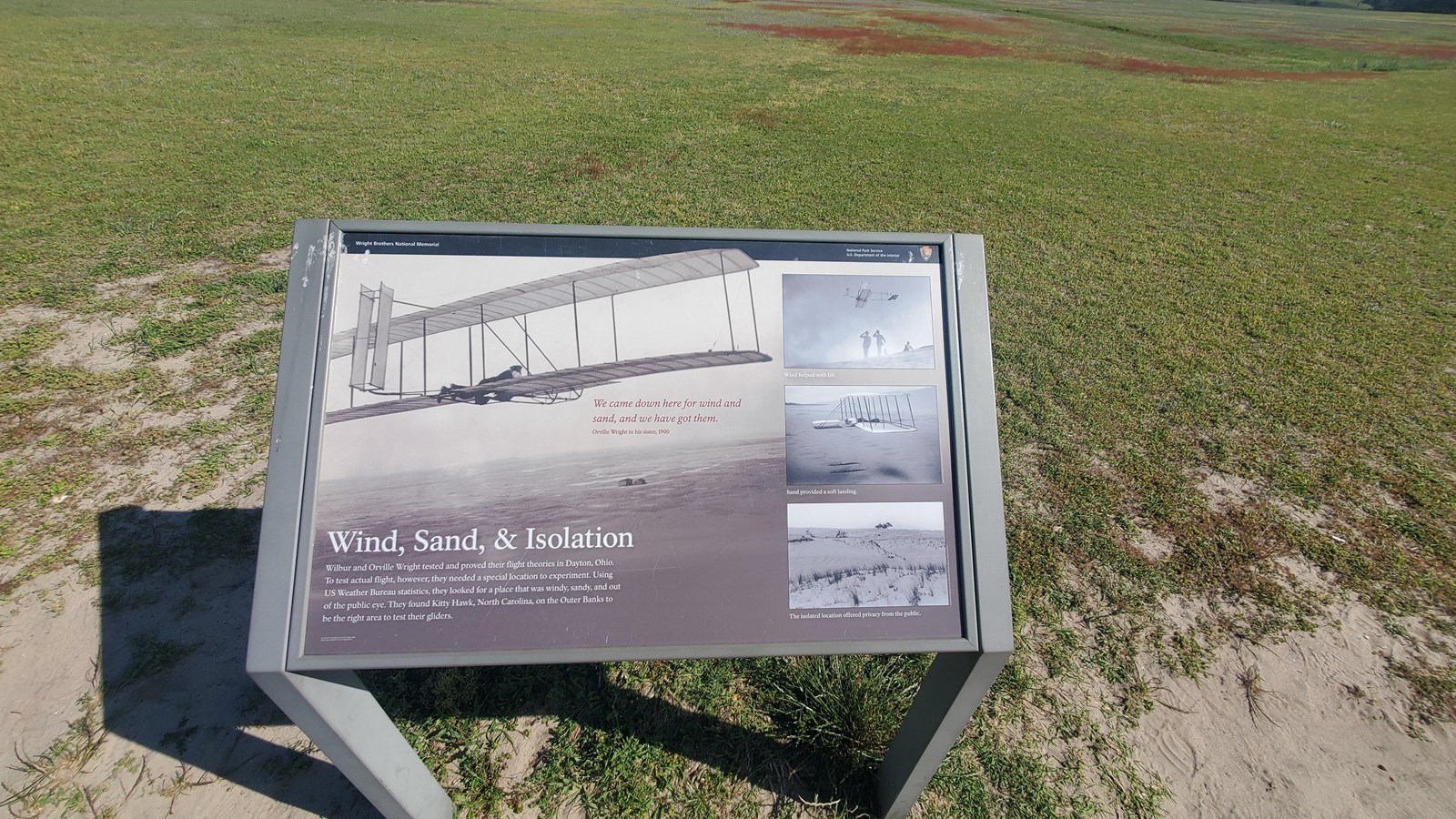Last updated: August 2, 2021
Place
2 - Wind, Sand, & Isolation

NPS
WAYSIDE TITLE: Wind, Sand, & Isolation.
WAYSIDE LAYOUT: Landscape-oriented rectangular panel featuring a black band across the top. The black band has text that reads, “Wright Brothers National Memorial” and “National Park Service U.S. Department of the Interior.” The panel has a large black and white photograph. In the center of the panel is a quote. The main body of text is located on the bottom left of the panel and there is a column of three photographs on the right.
VIEW FROM WAYSIDE: Slightly to the right is the monument in the far distance, atop a big grass covered hill. Directly in front of the wayside is a large, flat, open grass covered field. Looking to the right, there is a pathway leading to brown, wooden shed like buildings.
DESCRIPTION OF BACKGROUND IMAGE: A black and white photograph of a large, manned glider flying across the top left. Below the flyer is an aerial photograph overlooking the wide-open sandy, puddle filled landscape with two small wooden camp buildings in the distance.
QUOTE: “We came down here for wind and sand, and we have got them.” Orville Wright to his sister, 1900
TEXT: Wilbur and Orville Wright tested and proved their flight theories in Dayton, Ohio. To test actual flight, however, they needed a special location to experiment. Using US Weather Bureau statistics, they looked for a place that was windy, sandy, and out of the public eye. They found Kitty Hawk, North Carolina, on the Outer Banks to be the right area to test their gliders.
COLUMN OF IMAGES:
DESCRIPTION #1: A black and white photograph that shows two men standing, in dark clothing, holding their hats to their head, another man sitting on the ground wears much lighter colored clothing and is to the right. In the background, is the shadowy figure of another person in the distance. The men are looking towards the sky as a large glider flies past them overhead. The area close to the men is hazy, indicating that the sand is being blown by a strong wind.
CAPTION: Wind helped with lift.
DESCRIPTION #2: A black and white photograph of a pilot lying prone on a glider as it sits on a sandy surface.
CAPTION: Sand provided a soft landing.
DESCRIPTION #3: Black and white photograph of the sandy dune. There is a lone group of trees in the distance and a few patches of grass in the foreground.
CAPTION: The isolated location offered privacy from the public.
WAYSIDE LAYOUT: Landscape-oriented rectangular panel featuring a black band across the top. The black band has text that reads, “Wright Brothers National Memorial” and “National Park Service U.S. Department of the Interior.” The panel has a large black and white photograph. In the center of the panel is a quote. The main body of text is located on the bottom left of the panel and there is a column of three photographs on the right.
VIEW FROM WAYSIDE: Slightly to the right is the monument in the far distance, atop a big grass covered hill. Directly in front of the wayside is a large, flat, open grass covered field. Looking to the right, there is a pathway leading to brown, wooden shed like buildings.
DESCRIPTION OF BACKGROUND IMAGE: A black and white photograph of a large, manned glider flying across the top left. Below the flyer is an aerial photograph overlooking the wide-open sandy, puddle filled landscape with two small wooden camp buildings in the distance.
QUOTE: “We came down here for wind and sand, and we have got them.” Orville Wright to his sister, 1900
TEXT: Wilbur and Orville Wright tested and proved their flight theories in Dayton, Ohio. To test actual flight, however, they needed a special location to experiment. Using US Weather Bureau statistics, they looked for a place that was windy, sandy, and out of the public eye. They found Kitty Hawk, North Carolina, on the Outer Banks to be the right area to test their gliders.
COLUMN OF IMAGES:
DESCRIPTION #1: A black and white photograph that shows two men standing, in dark clothing, holding their hats to their head, another man sitting on the ground wears much lighter colored clothing and is to the right. In the background, is the shadowy figure of another person in the distance. The men are looking towards the sky as a large glider flies past them overhead. The area close to the men is hazy, indicating that the sand is being blown by a strong wind.
CAPTION: Wind helped with lift.
DESCRIPTION #2: A black and white photograph of a pilot lying prone on a glider as it sits on a sandy surface.
CAPTION: Sand provided a soft landing.
DESCRIPTION #3: Black and white photograph of the sandy dune. There is a lone group of trees in the distance and a few patches of grass in the foreground.
CAPTION: The isolated location offered privacy from the public.
